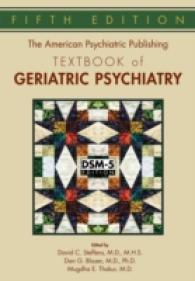- ホーム
- > 洋書
- > 英文書
- > Science / Mathematics
Full Description
Recent advances in brain science measurement technology have given researchers access to very large-scale time series data such as EEG/MEG data (20 to 100 dimensional) and fMRI (140,000 dimensional) data. To analyze such massive data, efficient computational and statistical methods are required.
Time Series Modeling of Neuroscience Data shows how to efficiently analyze neuroscience data by the Wiener-Kalman-Akaike approach, in which dynamic models of all kinds, such as linear/nonlinear differential equation models and time series models, are used for whitening the temporally dependent time series in the framework of linear/nonlinear state space models. Using as little mathematics as possible, this book explores some of its basic concepts and their derivatives as useful tools for time series analysis. Unique features include:
A statistical identification method of highly nonlinear dynamical systems such as the Hodgkin-Huxley model, Lorenz chaos model, Zetterberg Model, and more
Methods and applications for Dynamic Causality Analysis developed by Wiener, Granger, and Akaike
A state space modeling method for dynamicization of solutions for the Inverse Problems
A heteroscedastic state space modeling method for dynamic non-stationary signal decomposition for applications to signal detection problems in EEG data analysis
An innovation-based method for the characterization of nonlinear and/or non-Gaussian time series
An innovation-based method for spatial time series modeling for fMRI data analysis
The main point of interest in this book is to show that the same data can be treated using both a dynamical system and time series approach so that the neural and physiological information can be extracted more efficiently. Of course, time series modeling is valid not only in neuroscience data analysis but also in many other sciences and engineering fields where the statistical inference from the observed time series data plays an important role.
Contents
Introduction. Dynamic Models for Time Series Prediction: Time Series Prediction and the Power Spectrum. Discrete-Time Dynamic Models. Multivariate Dynamic Models. Continuous-Time Dynamic Models. Some More Models. Related Theories and Tools: Prediction and Doob Decomposition. Dynamics and Stationary Distributions. Bridge between Continuous-Time Models and Discrete-Time Models. Likelihood of Dynamic Models. State Space Modeling: Inference Problem (a) for State Space Models. Inference Problem (b) for State Space Models. Art of Likelihood Maximization. Causality Analysis. The New and Old Problems. References. Index.







